
Passiflora foetida is a species of passion flower that is native to the southwestern United States, Mexico, the Caribbean, Central America, and much of South America. It has been introduced to tropical regions around the world, such as Southeast Asia, South Asia, Hawaii, Africa, and The Maldives. It is a creeping vine like other members of the genus, and yields an edible fruit. The specific epithet, foetida, means "stinking" in Latin and refers to the strong aroma emitted by damaged foliage.

Croton is an extensive flowering plant genus in the spurge family, Euphorbiaceae. The plants of this genus were described and introduced to Europeans by Georg Eberhard Rumphius. The common names for this genus are rushfoil and croton, but the latter also refers to Codiaeum variegatum. The generic name comes from the Greek κρότος, which means "tick" and refers to the shape of the seeds of certain species.
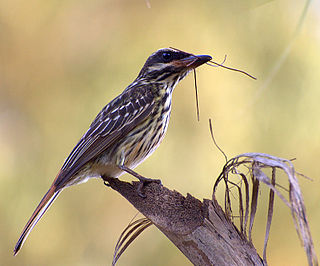
The streaked flycatcher is a passerine bird in the tyrant flycatcher family.

The southern beardless tyrannulet is a small passerine bird in the tyrant flycatcher family. It breeds from Costa Rica through South America south to Paraguay, Bolivia, and Argentina.
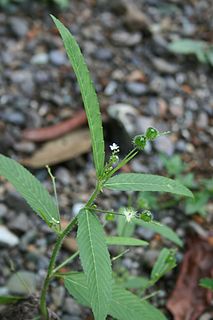
Caperonia is a genus of plants of the family Euphorbiaceae first described as a genus in 1825. The genus is native to tropical and subtropical America and Africa.

Joannesia is a genus of plants in the family Euphorbiaceae, first described as a genus in 1798. The entire genus is endemic to Brazil.
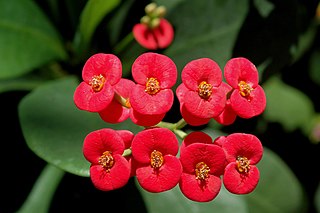
Euphorbia milii, the crown of thorns, Christ plant, or Christ thorn, is a species of flowering plant in the spurge family Euphorbiaceae, native to Madagascar. The species name commemorates Baron Milius, once Governor of Réunion, who introduced the species to France in 1821. It is imagined that the species was introduced to the Middle East in ancient times, and legend associates it with the crown of thorns worn by Christ. It is commonly used as an ornamental houseplant that can be grown in warmer climates. The common name is due to the thorns and deep red bracts referring to the crown thorn Jesus had to wear during his crucification and his blood.
In genetics, chromosomal polymorphism is a condition where one species contains members with varying chromosome counts or shapes. Polymorphism is a general concept in biology where more than one version of a trait is present in a population.
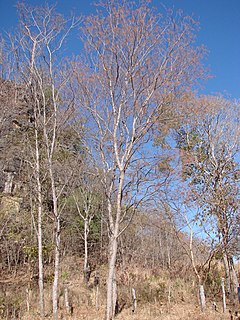
Myracrodruon urundeuva is a timber tree, which is often used for beekeeping. This plant is native from Argentina, Brazil, Bolivia and Paraguay, and it is typical of Caatinga, Cerrado, and Pantanal vegetation in Brazil.

Alchornea glandulosa is a tree species of the Acalyphoideae native to South America, growing for example in southern Brazil from Minas Gerais to Rio Grande do Sul. It is locally known as tamanqueiro, tapiá or amor seco. This gnarled tree grows preferentially in riparian forest, where it a common pioneer species growing to a height of 10–20 m. It is essentially evergreen, though in the hot austral summer months there is a more pronounced changeover of leaves, and branches are denuded to some extent.

The Euphorbiaceae, the spurge family, are a large family of flowering plants. In common English, they are sometimes called euphorbias, which is also the name of a genus in the family. Most spurges such as Euphorbia paralias are herbs, but some, especially in the tropics, are shrubs or trees, such as Hevea brasiliensis. Some, such as Euphorbia canariensis, are succulent and resemble cacti because of convergent evolution. This family occurs mainly in the tropics, with the majority of the species in the Indo-Malayan region and tropical America a strong second. A large variety occurs in tropical Africa, but they are not as abundant or varied as in the two other tropical regions. However, the Euphorbiaceae also have many species in nontropical areas such as the Mediterranean Basin, the Middle East, South Africa, and the Southern United States.
César Barbosa is a Colombian biologist, ornithologist and botanist, specialising in the study of Fabaceae.

The Poxim River is a river of Sergipe state in northeastern Brazil. The river runs through the sertão region of Sergipe. Its upper reaches are occupied by sugarcane farms (50%) and pastures (35%) and its mouth by an industrial zone. Almost all vegetation in the basin of the river and its tributaries has been removed, resulting in little diversity of flora and fauna in the region.

Croton lechleri is a species of flowering plant in the spurge family, Euphorbiaceae, that is native to northwestern South America. It is commonly known as sangre de grado, sangre de drago or sangre de grada, both of which translate to "dragon's blood". They refer to this tree's thick red latex.

Peraceae Klotzsch is a family of flowering plants in the eudicot order Malpighiales. The family was segregated from the Euphorbiaceae by Johann Friedrich Klotzsch in 1859, and its uniqueness was affirmed by the Royal Botanic Gardens, Kew's Euphorbiaceae expert, Airy Shaw.
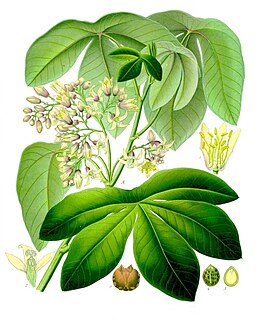
Manihot carthaginensis subsp. glaziovii, also known as Manihot glaziovii, the tree cassava or Ceara rubber tree, is a species of deciduous flowering plant in the spurge family, Euphorbiaceae, that is native to eastern Brazil.

The Botanical Garden of São Paulo is a botanical garden in São Paulo, Brazil. The park spans a 164.45 hectare area in the Fontes do Ipiranga State Park, at the district of Água Funda, in São Paulo's South zone, next to São Paulo Zoo. It houses the state's Botanical Institute. It was founded, in its current location, in 1928, by the botanist Frederico Carlos Hoehne.

Myrcia guianensis (pedra-ume-caá) is a species of the flowering plant family Myrtaceae. It is found in South America.

Campomanesia adamantium, commonly known as gabiroba, guavira, or guabiroba do campo, is a short shrub-like plant that grows no taller than 1.5 meters on average It is natively found in the central part of South America, in Paraguay and Brazil. The plant produces small yellow-green edible fruits
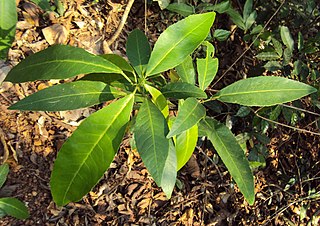
Croton persimilis is a species of tree in the Euphorbiaceae family. It is native to an area from Thailand in mainland Southeast Asia to southern Yunnan, China and to the Indian subcontinent. It is a pioneer species with a short life span. The plant is used in the traditional medicines of various peoples.

















